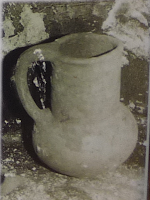In our last (and only other) installment, I wrote about the story of how Moshe Dayan sent down a young, very skinny girl through the hole in the floor of the building built above the ancient burial site. (A kind commenter corrected me - it was not Moshe Dayan's daughter, but that of an aide.) Nonetheless, she reported walking down a narrow corridor and finding a staircase, climbing the staircase and knocking on the rock she found at the top only to hear...someone knocking back. Sounds like a bad made-for-TV movie, but it really did happen.
She zipped back to the hole and climbed out, undoubtedly scared out of her wits. It wasn't clear whether they had told this poor young girl about the legends (Jewish and not) going back hundreds of years stating explicitly that anyone who ventured into the cave would die. In any case, my tour guide, Noam Arnon, said that when she came out and reported her findings, he realized that there was another way to enter the case.
Arnon knew that there were in fact two entrances to the cave - the first being the hole in the floor, and the other found at the far side of the cave, blocked by a huge stone. He surmised, correctly, that the cave had two entrances - one from the top and another from the side, and that when the girl knocked on the stone from the inside, someone had simply knocked back from the outside.
 |
| The hole in the wall |
As selichot progressed, they began to work. "ANA Hashem!" they'd scream. Boom! Boom! "Tekia!" WHAM! As the davening continued, young men hammered away at the stone. Eventually, davening ended when they removed the rock and did indeed find the staircase that they expected, leading them down. They entered the hole, and climbed down the stairs.
Arriving at the bottom, they walked down the corridor described by Michal and found...nothing. There wasn't anything there. They came back to the staircase. Again, nothing. Sooner or later, though, they realized that they felt a slight breeze. There must be something under them. Getting to work, they began to remove the stones in an area they found in the floor, and eventually uncovered a cave beneath them. They descended into that cave, and, as Arnon describes it, found pottery consistent with that found from the times of the Beit Hamikdash (I think he said Bayit Rishon, but I don't remember.) They then realized that the chamber they were in was an outer cave, leading to an inner cave - a cave within a cave - a double cave - (Me'arat Hamachpelah) and when they proceeded into the inner cave, Arnon said, "I realized that I was standing in the midst of human remains."
I'm not entirely sure how long they were down there, but time clearly was a factor. They needed to clean up, get out of the cave, and try to cover their tracks before the Arabs arrived in the morning. They reassembled the stone floor as best they could, recovered some pottery, made their way out of the cave, and tried to put the rock back where they found it.
 |
| Arnon's drawing of the cave |
After his talk, I had one question for Mr. Arnon: "Why didn't you take more pictures?"
He told me the obvious. Cameras thirty years ago were somewhat more complicated and difficult to manage than our point-and-clicks today. It was pitch black. Lighting was impossible. He took as many pictures as he could, but it's not like today, where you look at the screen and see what you've got. Anyone older than thirty will remember that way back, not more than ten years ago, you took a picture with something called "film", and you shot the picture and hoped for the best.
What you see is what came out.
 |
| Pottery from the Cave |
Its a tribute to Noam Arnon and the people who live in Hevron today, that we merit the ability to visit, pray and worship there today.


No comments:
Post a Comment
Comments transform a blog into a community. Please join.